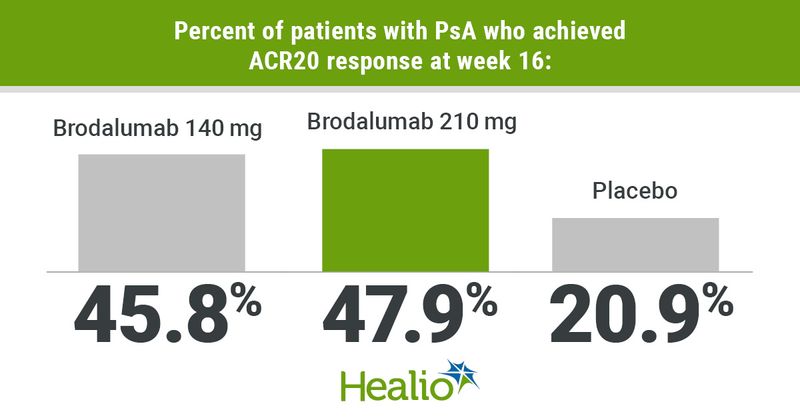Brodalumab linked to rapid, significant improvement in PsA
Treatment with brodalumab resulted in rapid and significant improvement in the signs and symptoms of psoriatic arthritis, compared with a placebo, according to data published in the Annals of the Rheumatic Diseases.
“Brodalumab is a fully human monoclonal antibody with a unique mechanism of action that binds to the IL-17 receptor subunit A (IL-17RA) with high affinity and, as a consequence, blocks the action of multiple proinflammatory cytokines of the IL-17 family, beyond that of IL-17A alone,” Philip J. Mease, MD, of the Swedish Medical Center, in Seattle, and colleagues wrote. “Brodalumab 210mg is currently approved for the treatment of moderate-to-severe plaque psoriasis in the US, EU, Canada and certain Asian countries, and for PsA currently only in Japan.”

“The efficacy and safety of brodalumab in PsA were evaluated in a phase 2, randomized, double-blind, placebo-controlled trial,” they added. “Brodalumab 140mg and 280mg once every 2 weeks (Q2W) were associated with significantly greater improvements in clinical response (ACR20; primary endpoint) versus placebo at 12 weeks. The safety profile of brodalumab in PsA was consistent with the safety profile established in the psoriasis clinical trial program, and clinical responses were sustained during an open-label extension up to week 52.”
To compare the safety and efficacy of brodalumab (Kyntheum, LEO Pharma) with placebo among patients with PsA, Mease and colleagues conducted two double-blind, randomized phase 3 trials — AMVISION-1 and AMVISION-2. For both trials, the researchers recruited adult patients with active PsA and inadequate response, or intolerance, to conventional treatment. A total of 962 participants — 478 in AMVISION-1 and 484 in AMVISION-2 — were randomized 1:1:1 to receive subcutaneous brodalumab doses of 140mg or 210mg, or a placebo.

Treatments were administered at weeks 0 and 1, and subsequently every 2 weeks up to week 24. About 30% of participants reported prior biologic use. The primary endpoint for both studies was the ACR20 response at week 16. In all, 693 participants, or 72% of the combined randomized population, completed the 24-week study period. Based on comparable design and eligibility criteria, the researchers opted to pool data from both studies.
According to the researchers, both trials met the primary endpoint. Significantly more patients achieved the ACR20 response at week 16 in both brodalumab treatment groups — 45.8% for 140 mg and 47.9% for 210mg — compared with 20.9% for placebo (P <.0001). These results remained similar at week 24. In addition, significantly higher proportions of patients treated with brodalumab achieved ACR50/70, Psoriasis Area and Severity Index 75/90/100 and resolution of dactylitis and enthesitis, compared with placebo (P < .01).
Adverse event rates at week 16 were 54.4% for placebo, 51.6% for brodalumab 140mg and 54.5% for brodalumab 210mg.
“The AMVISION-1 and AMVISION-2 trials showed that brodalumab 140mg and 210mg Q2W are associated with substantial improvements in both joint-related and skin-related endpoints versus placebo in patients with PsA, and these improvements are maintained through 24 weeks,” Mease and colleagues wrote.
“The safety profile of brodalumab was consistent with that reported in previous trials in psoriasis and the phase 2 PsA trial,” they added. “The favorable safety profile and efficacy data from these trials suggest that inhibition of IL-17RA with brodalumab, a unique mechanism of action, may represent an additional treatment strategy for patients with PsA.”
